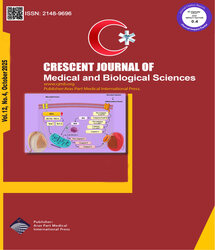

| Original Article | |
| Assessment of the Effect of Gene Polymorphisms and Environmental Risk Factors on Low HDL Over Time: Tehran Lipid and Glucose Study | |
| Yadollah Mehrabi1, Parvin Sarbakhsh2, Jeanine J. Houwing-Duistermaat3, Farid Zayeri4, Maryam Sadat Daneshpour5 | |
| 1Department of Epidemiology, Faculty of Public Health, Shahid Beheshti University of Medical Sciences, Tehran, Iran 2Women’s Reproductive Health Research Center, Tabriz University of Medical Sciences; and Department of Statistics and Epidemiology, School of Public Health, Tabriz University of Medical Sciences, Tabriz, Iran 3Department of Medical Statistics and Bioinformatics, Leiden University Medical Centre, Leiden, Netherlands 4Proteomics Research Center, Shahid Beheshti University of Medical Sciences, Tehran, Iran 5Cellular and Molecular Endocrine Research Center, Research Institute for Endocrine Sciences, Shahid Beheshti University of Medical Sciences, Tehran, Iran |
|
|
CJMB 2015; 2: 090-094 Viewed : 4066 times Downloaded : 2830 times. Keywords : Low HDL, Markov chains, Transition regression |
|
| Full Text(PDF) | Related Articles | |
| Abstract | |
Objective: Due to existing association between high-density lipoprotein (HDL) and cardiovascular disease, detection of factors affecting this lipid is important. Environmental factors and genetic variations have an important role in HDL level. The effects of these risk factors can be time-dependent; so, study of their effects on HDL level over time is important. In this study, we used transition model to analyze binary longitudinal data to investigate single nucleotide polymorphism (SNP) and other risk factors affecting low HDL over time. Materials and Methods: Data of 329 participants of 3 phases of Tehran Lipid and Glucose Study (TLGS) was analyzed using marginal transition model. This model has a formulation which allows first and second order Markov dependence to take into account the correlation among successive observations of the same individual in longitudinal binary response for which the marginal probability of success is modelled via a form of logistic regression. Results: Results of first order transition model showed that the odds ratio (OR) for having low HDL in women compared to men was 1.54 (95% CI: 1.02, 2.24). High waist circumference (OR = 1.67, CI 95%: 1.16, 2.39), high blood pressure (OR = 0.59, 95% CI: 0.41, 0.85), high triglyceride (OR = 1.85, 95% CI: 1.30, 2.65) and being homozygous for the minor allele of SRB1 (OR = 0.11, 95% CI: 0.01, 0.74) were significantly associated with low HDL. Also, the OR of low HDL in phase 2 of study compared to phase 1 was 1.76 (95% CI: 1.32, 2.35). The result of second order transition model was fairly similar to first order. The parameter estimates of serial dependency are markedly significant, pointing clearly to a first and second-order serial dependence (P < .001). Conclusion: Considering the identification of genetic and environmental factors affecting low HDL over time, transition model was used and the most important risk factors were identified. |
Cite By, Google Scholar
Google Scholar
PubMed
Online Submission System
 CJMB ENDNOTE ® Style
CJMB ENDNOTE ® Style
 Tutorials
Tutorials
 Publication Charge
Medical and Biological Research Center
About Journal
Publication Charge
Medical and Biological Research Center
About Journal
Aras Part Medical International Press Editor-in-Chief
Arash Khaki
Deputy Editor
Zafer Akan

















